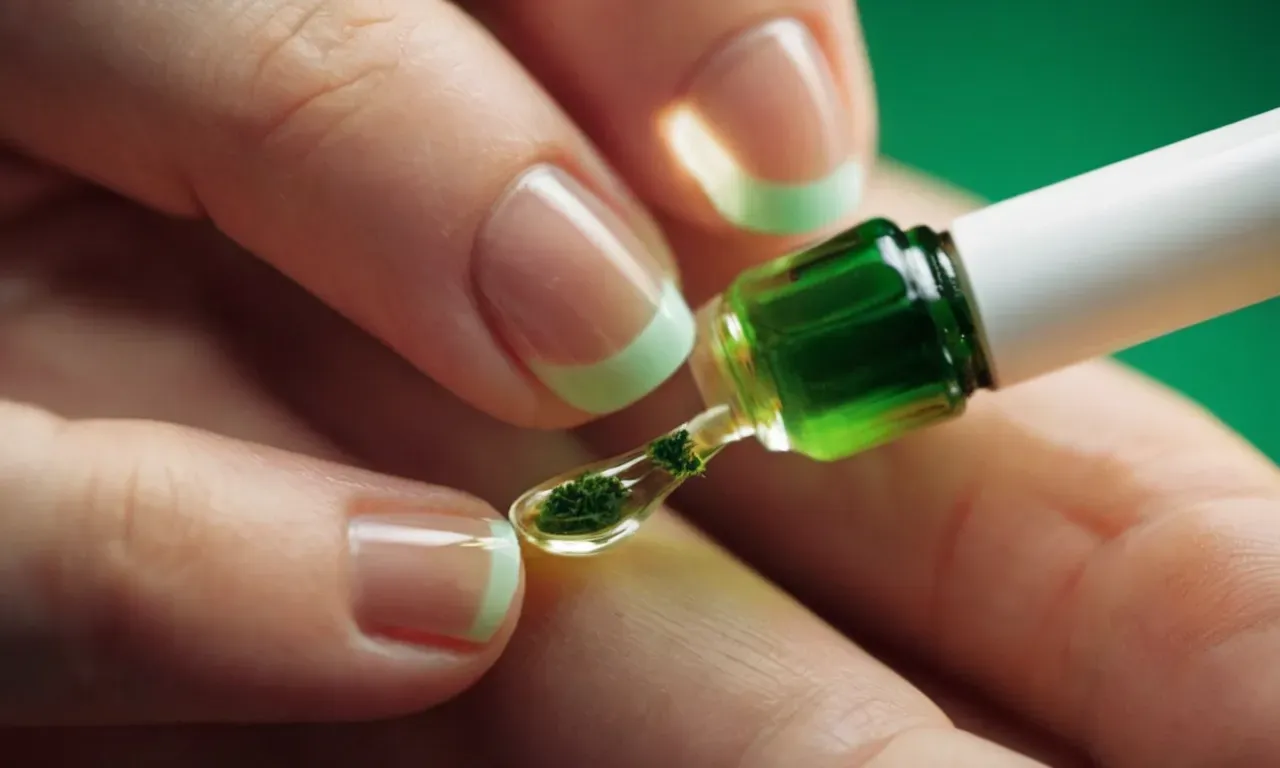How To Use Tea Tree Oil For Nail Fungus: A Comprehensive Guide
Nail fungus is an unpleasant condition that can cause nails to thicken, discolor, and become brittle. If you’re dealing with stubborn toenail or fingernail fungus, you may be wondering if tea tree oil can help get rid of it.
The good news is that tea tree oil is a proven natural antifungal that can be an effective part of a nail fungus treatment plan when used properly.
If you’re short on time, here’s a quick answer to your question: Applying diluted tea tree oil to affected nails daily, in combination with oral antifungal medication, can help clear up fungal nail infections by penetrating the nail and killing the fungus.
It takes persistence and consistency for months to see results.
What Causes Toenail and Fingernail Fungus
Overview of nail fungus causes
Nail fungus, also known as onychomycosis, is a common condition caused by fungi that infect the toenails or fingernails. The most common causes of nail fungus include:
- Dermatophytes – a group of fungi that commonly live on the skin, hair, and nails and can cause infections.
- Candida – a type of yeast that normally lives in the body in small amounts but can lead to infection when overgrown.
- Non-dermatophytic molds – fungi found in soil and decaying matter that can infect nails.
These fungi thrive in warm, moist environments like showers, pools, and inside shoes. When a microscopic break occurs in the nail, the fungi can enter and infect the nail bed and plate. As the infection worsens, the nail can become discolored, thickened, and brittle.
Common risk factors
Certain factors put people at a higher risk of developing nail fungus:
- Wearing tight-fitting or occlusive shoes that create a moist environment for fungi growth.
- Walking barefoot in damp communal areas like gyms, pools, and showers.
- Having a minor skin or nail injury that provides an entry point for fungi.
- Having a weakened immune system due to illness or medication.
- Having diabetes, peripheral vascular disease, or poor circulation.
- Smoking, which damages blood vessels and inhibits healing.
- Advanced age, as older adults have slower nail growth.
- Genetics and family history of fungal infections.
Men are more prone to toenail fungus while women are more likely to get fingernail fungus. Nail fungus can affect people of all ages but becomes more common after age 50.
Symptoms to watch out for
Signs and symptoms of a fungal nail infection include:
- Thickened, brittle, ragged, or distorted nails.
- White, black, yellow or green discoloration under the nail.
- Crumbly, flaky, or powdery-looking nails.
- Nails that separate from the nail bed.
- Debris accumulating under nails.
- Foul nail odor.
- Pain or tenderness of the nail.
Toenail fungus often starts at the edges of the nail and spreads toward the cuticle. Fingernail fungus tends to start at the cuticle and spread toward the edge. If left untreated, the infection can spread to other nails and may become more difficult to treat. Seeking early treatment is recommended.
Why Tea Tree Oil Works Against Nail Fungus
Antifungal properties of tea tree oil
Tea tree oil contains powerful antifungal compounds called terpenes that can help fight stubborn nail fungus infections. The main terpenes in tea tree oil are terpinen-4-ol, α-terpineol, and 1,8-cineole, which have been shown in studies to inhibit the growth and activity of various fungal strains that cause nail infections.
One study found that terpinen-4-ol completely stopped the growth of 79% of nail fungus samples tested in a lab dish. Another study showed that tea tree oil was able to penetrate fungal cells and damage their walls and membranes, preventing further growth and replication.
Besides its antifungal abilities, tea tree oil also has antibacterial and anti-inflammatory properties that can help reduce any swelling, redness and pain associated with fungal nail infections. Its immune-boosting effects may also help strengthen the body’s defenses against the fungus.
Ability to penetrate the nail
The compounds in tea tree oil are small enough to penetrate through the hard, keratinized surface of an infected nail. This allows the oil to reach fungal hyphae growing underneath and inside the nail and stop the infection at its source.
One study tested different essential oils’ nail penetration abilities and found that tea tree oil was able to penetrate human nails significantly better than other oils like eucalyptus, peppermint and lavender oils.
Tea tree oil’s deep penetrating power gives it an advantage over antifungal creams, which can only work on the surface of the nail and cannot reach and eliminate underlying fungus.
Research on efficacy for nail fungus treatment
Multiple studies have shown that tea tree oil can be an effective treatment for nail fungus infections when used on its own or combined with other antifungal agents.
One study followed patients using a 50% tea tree oil solution for nail fungus and found it was able to clear infections in about 18% of patients after 3 months of treatment. The oil worked significantly better when combined with oral antifungal medication.
Another research review looked at the results of 4 studies on tea tree oil for nail fungus. It found that tea tree oil provided both antifungal and anti-inflammatory benefits and was able to clear about 60% of nail fungal infections with consistent use.
While research shows pure tea tree oil works better, many people find success using over-the-counter antifungal nail polishes, creams and solutions containing tea tree oil. These provide lower concentrations of tea tree oil along with additional antifungal ingredients.
How to Use Tea Tree Oil for Nail Fungus
Diluting tea tree oil safely
Tea tree oil is very potent and can cause skin irritation if used undiluted. According to the Mayo Clinic[1], it’s best to dilute tea tree oil before applying it to nails affected by fungus. A common dilution ratio is 1 part tea tree oil to 4 parts carrier oil, such as coconut or olive oil.
Mix the ingredients thoroughly before each application.
Application instructions
Apply the diluted tea tree oil mixture directly to clean nails using a cotton swab or clean brush 1-2 times per day, ideally after showering. Allow the mixture to completely dry on nails for optimal absorption and effectiveness against fungus. The key is consistency; diligent applications may yield better results over time.
How often to apply
Research on tea tree oil for nail fungus is limited, but sources like the Mayo Clinic suggest applying it 1-2 times daily for at least 6 weeks. Nail fungus can be stubborn, so continuing 3-6 month applications may be worthwhile to help clear infections, prevent recurrence and support healthy nail regrowth over time.
Complementary treatments
While evidence on tea tree oil and nail fungus is promising, utilizing complementary treatments can boost outcomes. Other beneficial options include:
- Prescription oral antifungal medications, especially for moderate to severe infections.
- Over-the-counter nail fungus creams or solutions with ingredients like undecylenic acid or tolnaftate.
- Frequent nail cleaning and hygiene to prevent reinfection.
- Nail filing or debridement to remove infected nail matter and promote healing.
An integrative plan coupling safe at-home treatments like tea tree oil alongside standard medical care as needed may provide greater nail fungus relief with continued applications over months.
What to Expect When Using Tea Tree Oil
How long it takes to work
Tea tree oil is an effective natural treatment for nail fungus, but like most treatments, it requires patience and consistency to see results. Here’s a general timeline of what to expect:
- 1-2 weeks: You may start to notice some improvement in nail appearance as the antifungal properties of tea tree oil start working. The oil will begin penetrating the nail and fighting the fungal infection.
- 4-6 weeks: With consistent application, you should see more definite clearing of the infected part of the nail. The newer nail growth at the base should look healthier.
- 3-6 months: Over this time period of diligent use, the infected nail will likely be replaced by new, healthy nail growth. The fungus should be eradicated.
However, the exact timeline can vary based on factors like the severity of infection, consistency of application, and your body’s response. Patience is key.
Signs it’s working
Here are some signs that the tea tree oil treatment is effectively fighting your nail fungus:
- The infected area starts to look less thickened and discolored
- The nail becomes less brittle and rigid
- Debris buildup under nail begins to clear
- New nail growth at base looks smoother, with normal color
- Nail starts to regain its natural shape
- Itching and pain around nail decreases
You’ll likely notice the nail gradually improving with a healthier appearance. Take before and after pictures to track changes. If using tea tree oil and not seeing improvement after 2-3 months, consult your doctor.
Potential side effects and risks
Tea tree oil is generally safe when used topically in small amounts. But be aware of potential side effects:
- Skin irritation – Redness, dryness, itching, burning or rash may occur, especially with sensitive skin. Do a patch test first.
- Accidental swallowing – Nausea, dizziness and confusion have been reported if tea tree oil is swallowed. Keep out of reach of children.
- Allergic reactions – Discontinue use if hives, swelling or severe itching develops.
- Photosensitivity – May increase sun sensitivity. Avoid direct sunlight after application.
- Interactions – Those on blood thinners or antifungals should consult a doctor first.
Always use a carrier oil like coconut or olive oil to dilute pure tea tree oil before applying to skin. Start with low concentrations. Properly store in a dark glass bottle to maintain efficacy. While relatively low risk, be cautious and alert to any adverse effects. Discuss concerns with your doctor.
Tips for Maximizing Results
Be patient and persistent
Treating nail fungus requires dedication and perseverance. According to the American Academy of Dermatology, it can take anywhere from 6 to 12 weeks before seeing improvements when using antifungal treatments. So don’t get discouraged if you don’t see changes right away.
Stick with your tea tree oil regimen and you should start seeing healthier nails over time.
Use it along with oral antifungals
Using tea tree oil together with oral antifungal medications can boost treatment effectiveness. A study in the Journal of Family Practice showed that participants who used topical tea tree oil and oral antifungals had more significant nail fungus improvement than those only using antifungals.
So speak to your doctor about supplementing your prescription with tea tree oil application.
Keep nails clean and dry
Preventing moisture buildup under and around nails is crucial when battling fungal infections. After showering or washing hands, thoroughly dry fingers and toes, wiping in between nails. It is also wise to trim nails short, file down thickened parts, and avoid wearing nail polish as that can trap moisture.
Keeping the nail area clean and dry helps limit fungus growth.
Disinfect shoes and tools
Fungus spores can live on surfaces like nail clippers, files, and footwear. So it’s essential to disinfect these items to avoid recontamination. After each use, clean tools with hot soapy water or rubbing alcohol. Regarding shoes, spray the insides with tea tree oil solution or an antifungal spray.
Also, don’t share pedicure instruments or nail polish with others.
Avoid reinfection
Taking preventative steps can help stop fungal reinfection after treatment. These include:
- Wear shower shoes or flip flops in public showers/locker rooms
- Don’t go barefoot outdoors where fungus lives in soil/grass
- Disinfect home pedicure tools after each use
- Replace old shoes and socks regularly
- Apply antifungal powder inside shoes
Staying vigilant can help sustain nail health long-term after addressing a fungal infection. Consult a podiatrist or dermatologist if symptoms return.
Conclusion
While tea tree oil isn’t a standalone cure for nail fungus, it can be an effective complementary treatment when used properly and consistently. Along with oral antifungal medications, applying diluted tea tree oil daily may help clear up stubborn fungal nail infections.
Make sure to practice good nail hygiene to avoid reinfection as you wait patiently for healthy nails to grow back in.
The key is staying persistent with the tea tree oil regimen for several months. If you follow these tips and recommendations, you may finally beat troublesome toenail or fingernail fungus for good.







